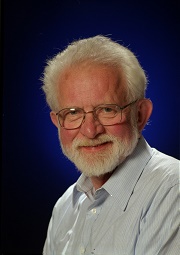
William A. Clemens Jr.
Professor of Paleontology and Integrative Biology, Emeritus
William A. Clemens Jr., longtime Professor of paleontology and integrative biology, curator in the University of California Museum of Paleontology, Berkeley, and one of the greatest fossil mammal experts of the past century, passed away peacefully at his home in Berkeley on 17 November 2020, surrounded by family and letters and tributes from friends and colleagues around the globe. He was 88.
For 60 years, Bill was one of the premier authorities in the world on the origin, diversification, and geographical spread of the first mammaliaforms, animals that include living mammal groups and also those mammalian precursors that eventually became extinct. His research focused on the Mesozoic and earliest Paleocene forms. During this interval most mammals were the size of shrews and smaller rodents. They are overwhelmingly represented by isolated teeth, or occasionally by partial or (rarely) entire jaws, the most durable parts of their otherwise fragile skeletons. Bill used the morphology of these remains to classify them, to discern their relationships to other groups, to chart their spread through time and space, and to infer the evolution of their diets and locomotory patterns.
Although Bill published on fossils throughout the Mesozoic and early Paleogene, his primary contributions fell into two time intervals. The first was the Triassic-Jurassic boundary, which witnessed the rise and diversification of the first mammaliaforms. Their descendants radiated through the Mesozoic Era and include all living groups of mammals. These groups, then and now, are mainly known from the Northern Hemisphere, and Bill spent several years in Europe on Guggenheim and Humboldt Foundation awards describing their morphology and evolution.
The second interval of interest was the Cretaceous-Paleogene (K/Pg) boundary, a time when the great groups of Mesozoic dinosaurs became extinct, and the living groups of mammals began a great radiation. Although Bill and his students worked on most of these groups, he made particularly important contributions to our knowledge of marsupials, which radiated in North America before disappearing there in the early Tertiary, only to flourish in Europe, South America, and eventually Australia. He also pioneered our understanding of the early evolution of placental mammals, publishing on the earliest representatives of primates, hoofed mammals, and insectivorous lineages.
Bill’s research was grounded in decades of fieldwork. Beginning in 1970 and continuing through 2019, he and his students and colleagues returned each summer to prospect and quarry the Upper Cretaceous and lower Paleogene deposits of eastern Montana, developing a detailed, stratigraphically controlled paleontological dataset and geologic framework for addressing questions of the timing and patterns of faunal change across the K/Pg boundary. His insights were gained painstakingly through the wholesale excavation and screen-washing of tons of sedimentary rock that had shown the promise of preserving thousands upon thousands of tiny fragments of fossil vertebrates.
The importance of all those fossils and that detailed stratigraphic framework was magnified in 1980 when UC Berkeley scientists Luis and Walter Alvarez and colleagues reported the discovery of anomalous quantities of the noble metal iridium at the K-Pg boundary, hypothesizing that an asteroid impact had caused the end-Cretaceous mass extinction. While scientists throughout the world were studying this extinction event in marine sections, Bill and his students and colleagues had long been developing the primary record of terrestrial extinction patterns in the U.S. Western Interior. To this day, vibrant conversations begun by Bill Clemens and Walter Alvarez in the 1980s continue on the patterns and causes of the end-Cretaceous extinctions, especially the relative roles of the impact, extensive volcanism, the retreat of the Western Interior Seaway, and other climatic changes.
Bill was the major professor of nearly two dozen Ph.D. students and was a great influence on dozens of others, at Berkeley and around the globe, expanding the great Berkeley tradition in paleomammalogy. Beyond this, he served as President of the Society of Vertebrate Paleontology, Trustee and eventually President of the California Academy of Sciences, and Director of the University of California Museum of Paleontology. Bill was given the Romer-Simpson Medal and the Joseph T. Gregory Award by the Society of Vertebrate Paleontology, two of its highest honors. He was also a Fellow of the Geological Society of America.
Bill was born in Berkeley on May 15, 1932, received his Bachelor’s and Ph.D. degrees at UC Berkeley, and served for seven years on the faculty at the University of Kansas before returning to join the Berkeley faculty from 1967 to 2002. Bill remained an active emeritus professor, participating in seminars and public programs at the Museum and serving on doctoral committees while pursuing his research. His campus activities included many years of service to the Academic Senate. He served on the Library Committee from 1975-78 and 1992-95, and then on to the Graduate Council from 1997-2000. Bill’s oral history has been recorded by the Bancroft Library: “Caution and Care: William A. Clemens and the Evolution of Paleontology at the University of California Berkeley” (2017).
Bill was predeceased by his wife Dorothy in 2015. He is survived by their children, Catherine, Elisabeth, Diane, and William, as well as their spouses and seven grandchildren. Always thoughtful and supportive, his legacy will be felt at Berkeley and beyond for many years to come.
Kevin Padian
2020
